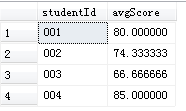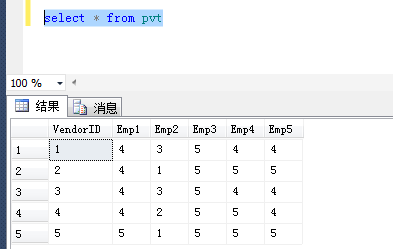pivot
可以把列值转换为输出中的多个列。
pivot 可以在其他剩余的列的值上执行聚合函数。
unpivot
将列转换为列值
语法
SELECT <non-pivoted column>,
[first pivoted column] AS <column name>,
[second pivoted column] AS <column name>,
...
[last pivoted column] AS <column name>
FROM
(<SELECT query that produces the data>)
AS <alias for the source query>
PIVOT
(
<aggregation function>(<column being aggregated>)
FOR
[<column that contains the values that will become column headers>]
IN ( [first pivoted column], [second pivoted column],
... [last pivoted column])
) AS <alias for the pivot table>
<optional ORDER BY clause>;
示例1:pivot
1.数据准备
create table student_score ( studentId varchar(50), subjectName varchar(50), score decimal(18) ) insert into student_score values ('001','语文',80),('001','数学',70),('001','英语',90), ('002','语文',80),('002','数学',83),('002','英语',60), ('003','语文',50),('003','数学',90),('003','英语',60), ('004','语文',90),('004','数学',80)
按学生id分组查看平均成绩
select studentId,AVG(score) avgScore from student_score group by studentId
初始效果

2.使用pivot
select 'averagescore' as avgScore_by_studentId, [001],[002],[003],[004] from ( select studentId,score from student_score ) as sourceTable pivot ( AVG(score) for studentId in ([001],[002],[003],[004]) ) as pivotTable
3.效果

示例2:unpivot
1.数据准备
-- Create the table and insert values as portrayed in the previous example. CREATE TABLE pvt (VendorID int, Emp1 int, Emp2 int, Emp3 int, Emp4 int, Emp5 int); GO INSERT INTO pvt VALUES (1,4,3,5,4,4); INSERT INTO pvt VALUES (2,4,1,5,5,5); INSERT INTO pvt VALUES (3,4,3,5,4,4); INSERT INTO pvt VALUES (4,4,2,5,5,4); INSERT INTO pvt VALUES (5,5,1,5,5,5); GO
初始效果

表示供应商(vendorID)在用户1(Emp1)中的订单数量,其他类比即可。
2.使用示例
-- Unpivot the table. SELECT VendorID, Employee, Orders FROM (SELECT VendorID, Emp1, Emp2, Emp3, Emp4, Emp5 FROM pvt) p UNPIVOT (Orders FOR Employee IN (Emp1, Emp2, Emp3, Emp4, Emp5) )AS unpvt;
3.效果
